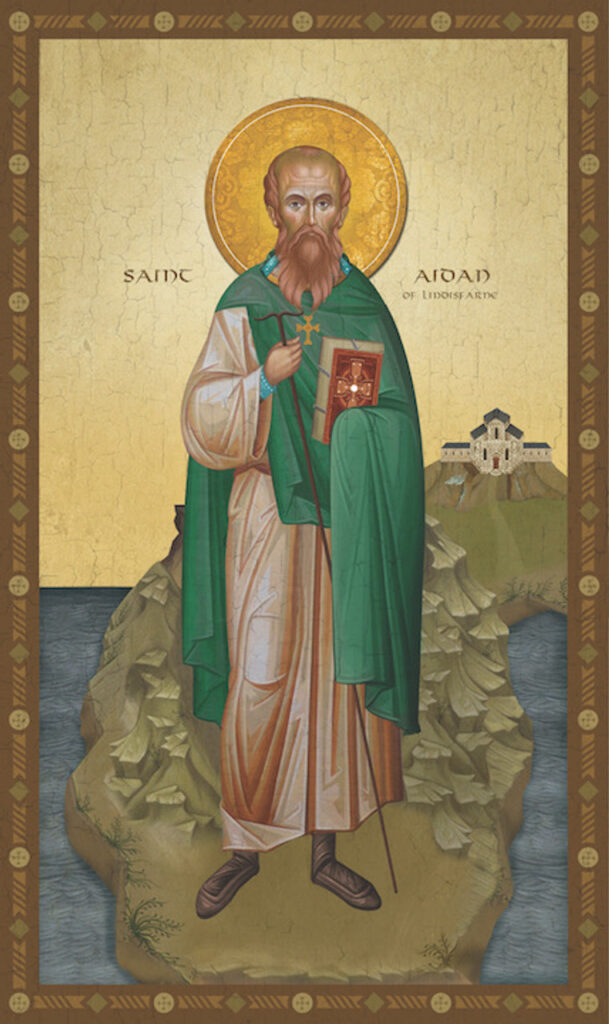
St Aidan, the first Bishop of Lindisfarne (Holy Island), known as the Apostle of the North, and by some as the Apostle of England, came as a missionary monk to teach Christianity to the Anglo-Saxons of Northumbria.
The Anglo-Saxons, wild, fierce people, having been converted to Christianity by St Paulinus, had reverted back to paganism at the death of King Edwin.
St Aidan, even though he could not speak their language, by the sheer force of his personality, brought them back to Christianity.
In the words of the Venerable Bede, ‘and they sent him Bishop Aidan, a man of outstanding gentleness, holiness and moderation.’ ‘He gave his clergy an inspiring example of self-discipline and continence and the highest commendation of his teaching to all was that he and his followers lived as they taught.’ Again Bede says, ‘He cultivated peace and love, purity and humility; he was above anger and greed, and despised pride and conceit; he set himself to help and teach the laws of God and was diligent in study and prayer.’
The symbols traditionally connected with St Aidan were a stag and a torch. The torch, representing the light of Christianity is most appropriate and it is interesting when one considers how it seems to have been passed from one saint to another. St Martin founded the monastery at Tours, inspired by the life of St Anthony by Athanasius. St Martin died in 397. St Ninian, who studied at Rome and under St Martin built his monastery, known as Candida Cassa, in Wigtownshire in 397. St Ninian died in 432. St Patrick landed in Ireland in 432. He was baptised by Caranoe, successor to St Ninian at Candida Cassa, according to one tradition. Both his father and grandfather were Christians living nearby, and were most likely converted by the influence of St Ninian. St Patrick founded the Irish Church, one of whose great sons, St Columba, founded the monastery at Iona in 563 and who died in 597. St Aidan was a Celt from Iona.
The king of Northumbria, Oswald, had sent to Iona for a missionary to convert his people to Christianity. A monk name Corman, of an austere personality, had been sent, but he returned disgusted having said the Northumbrians were an impossible people.
The monks, in council, debated what was to be done. St Aidan rose, and rebuked Corman, saying, ‘Brother, you were too severe to your unlearned hearers, you should first give them the milk of more easy doctrine, and then taught them the sublime precepts of God.’ All present at this council realised that Aidan was the suitable person to send. He was consecrated bishop and landed in Northumbria in 643 with twelve disciples.
The king gave him Lindisfarne as his headquarters. From this island spread Christianity all over the North. Many were St Aidan’s pupils, inspired by his example, including St Finan, St Chad, St Cedda, St Hilda and St Wilfrid, and the island became known as Holy Island because of the great number of saints who were associated with it.
There are many tales related of St Aidan’s life. One is that he was given the gift of a horse by the king, though he usually travelled on foot. One day meeting a poor man, who asked him for alms, he dismounted and gave him his horse. The king, on being told of this, said, ‘My Lord Bishop, why should you give the poor man that royal horse, which was necessary for your use? Had we not many horses of less value?’ The bishop answered, ‘Is that fool of a mare more dear to you than the Son of God?’ The king besought St Aidan’s forgiveness saying, ‘I will not judge in future, of what or of how much of our money you should give to the sons of God.’
There are several miracles related of him. One of him calming a storm at sea; one, when he has retired to pray of the Farne Islands and seeing flames burning the city of Bamburgh called on God to notice the evil; immediately the wind turned the flames away from the city.
This man truly went about doing good and was venerated from the North to the South even as far as Canterbury.
After he had been bishop for seventeen years, he became sick, and a tent was set up for him against the wall of a church near the king’s house. He died on the last day of August in 651, leaning against a wooden post. When later this church was burnt down by pagans twice in succession, the fire never consumed the post.
His body was taken to Lindisfarne and buried there.
On the night of his death a young boy was tending his sheep on mountains near Melrose. He saw a vision of angels bearing a soul to heaven. This so impressed him that next morning he went to the monastery of Mailros (Melrose) nearby and learnt that St Aidan has died at the moment of his vision. He became a monk at this monastery, which was one of those founded by St Aidan. Later this boy became a future bishop of Lindisfarne, and is known as St Cuthbert, thus carrying on the torch.